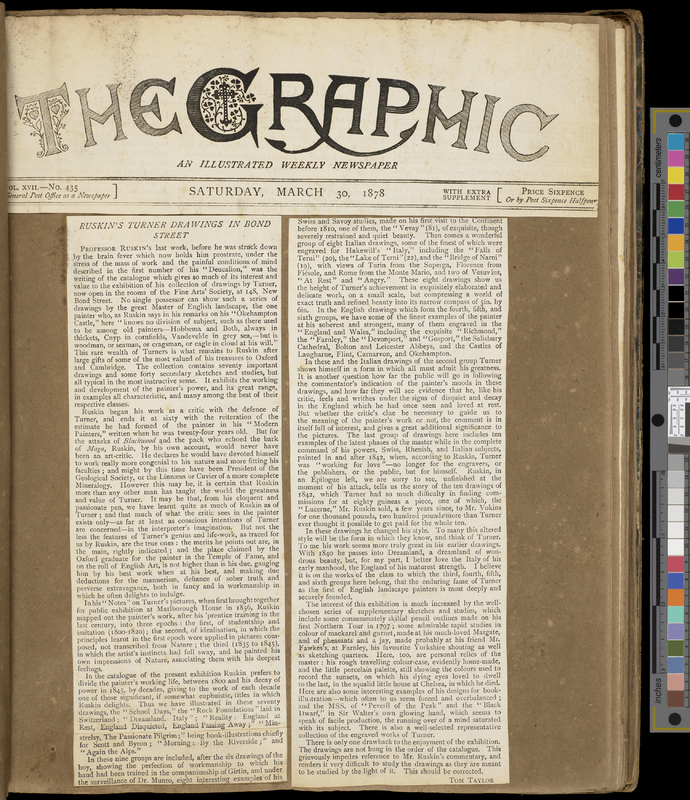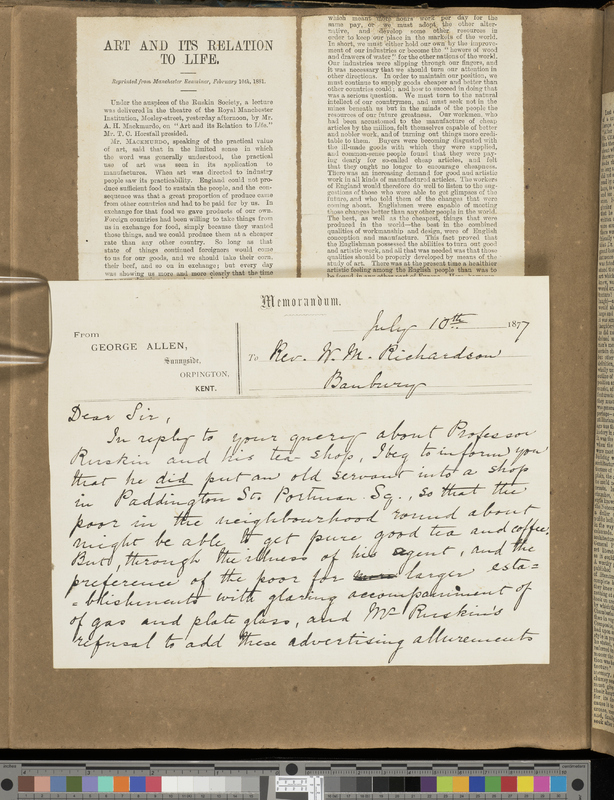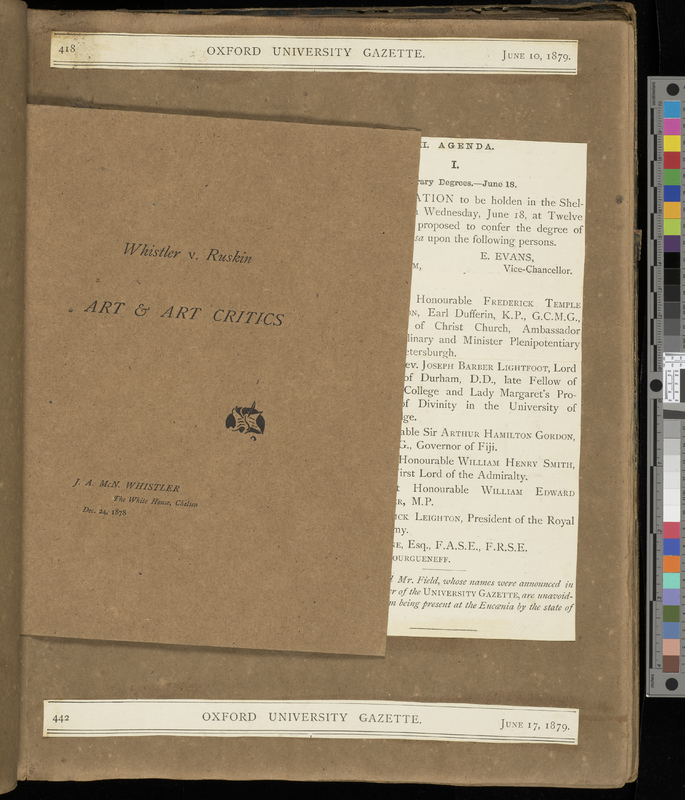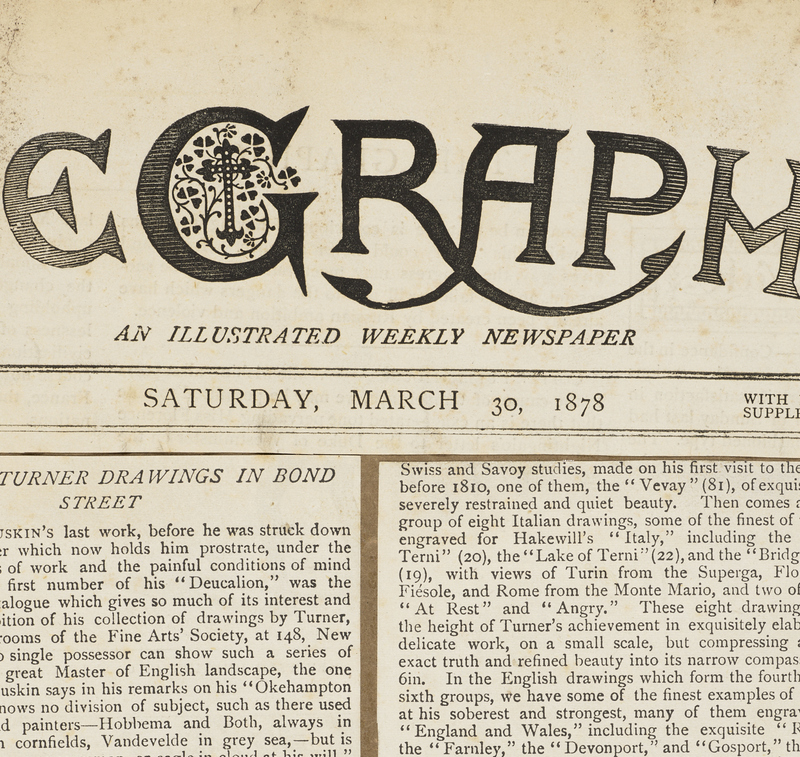Frederick Langton’s Scrapbook
Item
-
Title
-
Frederick Langton’s Scrapbook
-
Description
-
Frederick W. Langton’s scrapbook was created in the latter part of the nineteenth century, at a time when periodical publications were proliferating. Presented above are selected pages from Langton’s “Ruskiniana” scrapbook, a collection of documents taken from periodicals about the art critic John Ruskin.
One page from the album features two typed newspaper columns cut and pasted onto a brown piece of paper. The two columns are carefully placed side by side in the middle of the page, leaving a slight brown gap between them. The newspaper’s masthead is pasted at the top of the page, identifying the source of the typed columns as an issue of “The Graphic” from 30 March 1878. Another album page includes two pages of an article entitled “Art and Its Relation to Life” pasted side by side, with a line of the album’s brown paper separating the two densely printed sheets. A handwritten note pasted in just below these two pages slightly overlaps the article when it is unfolded for reading, as in the photograph included above. Printed text at the top of the note identifies it as a “Memorandum from George Allen, Sunnyside, Orpinton, Kent.” The memorandum is addressed by hand to “Rev. W. M. Richardson, Banbury” and dated 10 July 1877. The memorandum begins, “Dear Sir, In reply to your query about Professor Ruskin and his tea-shop, I beg to inform you that he did put an old servant into a shop… so that the poor in the neighbourhood round about might be able to get pure good tea and coffee.”
Another section of the scrapbook emphasizes the variety of materials included in the album: in addition to printed and hand-written materials, Langton included a full pamphlet, “Whistler v. Ruskin: Art & Art Critics,” written by James McNeill Whistler and published on 24 December 1878.
-
ALISON HEDLEY ON WHAT THIS OBJECT TEACHES US:
Dr. Hedley explains that a scrapbook can offer a glimpse into its maker’s understanding of print media or what we might today call their media literacy. In the case of Frederick Langton’s scrapbook, we are presented with an archive of materials about art critic John Ruskin, as well as a record of Langton’s engagement with and understanding of printed materials.
Reverend Frederick W. Langton, the vicar of the village of Ponteland in Northumberland, created this scrapbook between the 1870s and 1890s, filling it with “Ruskiniana”—a term he used to describe the periodical clippings and other records related to Ruskin that he collected. In addition to approaching the scrapbook as a curated selection of texts about Ruskin, Dr. Hedley encourages us to consider what the scrapbook tells us about Langton’s understanding of the production and design of Victorian periodicals. She notes that Langton may have had knowledge of periodical publishing since his scrapbook mirrors the techniques used by Victorian publishers of bringing together various articles from different sources, often on a single page. Langton organized and filled out his scrapbook’s pages with attention to layout, carefully spacing columns in relation to their headings. Dr. Hedley suggests that Langton’s formatting choices were calculated, emulating periodical conventions as a means of legitimizing his collection while also balancing readability with economy of space.
Langton also explored alternative design features in his scrapbook; for example, the handwritten memo is folded in two, with only one half pasted onto the album’s page so that readers can unfold the letter to read its full contents. The multi-page Whistler v. Ruskin pamphlet also disrupts the flat surface that we expect from printed pages: the entire pamphlet is included within the scrapbook rather than being disassembled and pasted in page by page. Dr. Hedley points out that this may have been a deliberate choice on Langton’s part since the pamphlet, which was authored by Whistler after he sued Ruskin for libel, goes against the scrapbook’s celebratory treatment of Ruskin. By physically separating Whistler’s text within the pamphlet from other information about the quarrel pasted on surrounding pages, Langton ensures that Whistler’s opinions remain detached from the overall message of the scrapbook.
Dr. Hedley suggests that we can think about Langton’s scrapbook in contemporary terms as “a Ruskin fanboy album,” and compare it to current “fanboy” collections about celebrities and musicians. Just like today’s collections, which may include digital images and videos brought together online, Langton’s collection was influenced by the media that surrounded him, and his presentation of the collection provides evidence of his fluency with those media forms.







